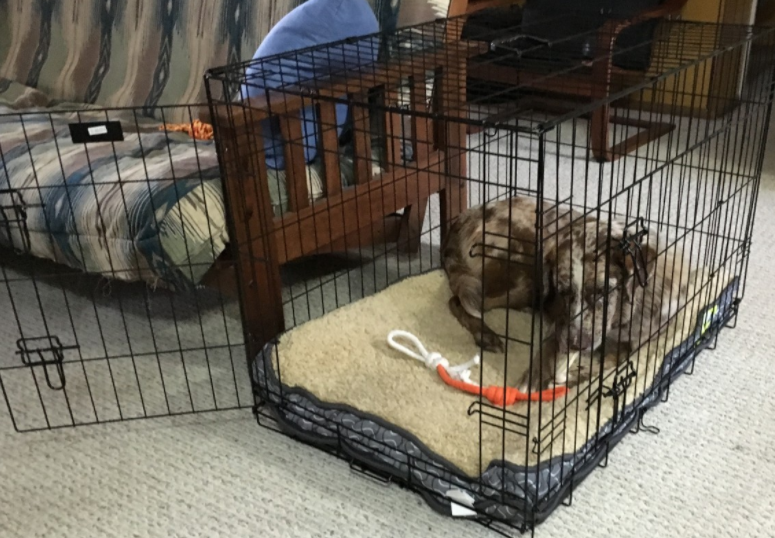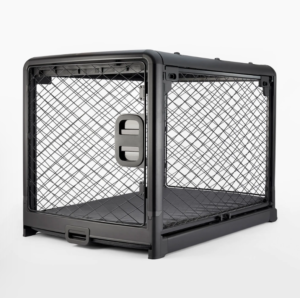
24 SepCrate training a dog: The why and the how
As dog trainers, we often encounter new dog owners who resist the idea of getting a crate because they feel it'll take up too much room, or they don't like the idea of confining their dog. But crate training can be helpful when house training a dog, and teaching them how to be alone.
To crate or not to crate?
A crate is not compulsory, but it can be a great tool for good trainers who want to help prevent unwanted behaviors and encourage desired ones in situations where you can’t have your dog in an otherwise enclosed, dog-proofed space.
If you introduce it to your dog correctly, they can actually grow to love it.
Early associations with new spaces and objects are important and, often, indelible. For this reason, you can’t just throw your dog in the crate and expect him to adjust – for most dogs that experience would be traumatic. Crate training should be done over time. You'll want to start out by making the crate comfy with a nice pad or blanket, situate it in a high traffic area like the kitchen and, whenever the dog isn’t looking, drop a couple of treats in the back. Don’t point these out to him, rather let him discover them on his own. Feed him meals in there, with the door open for now. Using heavy string, tie an attractive food-stuffed chew-toy to the rear inside so that the dog must lie in the crate in order to chew on it. (Flossies or bully sticks also work really well.)
Adding a cue
Teach your dog to enter and exit the crate on cue. Say “into bed” or “into the crate,” throw a treat into the crate, then praise as the dog goes in and eats the treat. When you first start crate training your dog, you may choose to reward him even if he only goes in part of the way. Once he is going in all the way, you can start to encourage him to come out (you can give it a cue, like “Come on out!”). When he does, praise him, but there’s no need to offer a food treat for exiting. The really good stuff when he goes in, not when he comes out.
Repeat this a few times and then change the order of events slightly: instead of throwing the treat into the crate after you say “into bed,” wait for him to go in on his own before dropping in the treat. If he doesn’t enter on cue, simply wait. Do not cue him a second time and do not crack and throw the treat in. You can encourage him in with hand gestures but even this is riskier than simply waiting. If he doesn’t go in, end the crate training session without comment.
Try another session in a little while, still withholding the reward until he goes in on. When he does (and they all do eventually so hang in there), give him a double or triple reward, do a few more rewarded reps and then end the session. Always leave your dog wanting more. Whenever you spot him hanging out in the crate without your asking, throw in a treat.
When your dog is going in and out on command, you are ready to try the first lock-in. Play the in-out-of-the-crate game, only now close the door after he has gone in and feed him treats through the grate for a minute or two before opening the door. Do this several times. Then practice walking around the crate and around the room while he is locked inside, pitching treats at him occasionally and then, after a couple of minutes, opening the door and letting him out. Make the whole thing a positive experience for him. The next step will be to add some real duration.
Adding duration
Turn on a favorite TV show and stuff a couple of Kongs or Toppls with something extra-special and have a couple of small and yummy treats on hand, too. Set up the crate next to your sofa and, just before you sit down, give the cue for going in the crate. When he goes in, give him the chew toys, then close the crate door.
You should leave the room a few times to get a drink or use the rest room, but always come back within a minute or so. The first experience being locked in the crate for this length of time must be an overwhelmingly easy and good one. Any noise, agitation or tantrum should be ignored. During the moments when he is relaxed and quiet, toss in a treat.

The Revol is an easily folding dog crate that we use at School For The Dogs.
At the end of your TV show, if your dog is quiet and settled in the crate, simply open the door. Under no circumstances will you open the door to the crate if the dog is misbehaving, otherwise you will be encouraging that behavior. When you do open the door, don’t gush and hug him. Make the exit an anticlimax. Behave very neutrally. All the good stuff should happen while he’s IN the crate, behaving nicely.
Once he’s out, give the cue for him to go right back in for a food treat or two, but don’t close the door this time.
Now spend a few days locking the dog in the crate when you’re at home, going about your usual business. Ignore any noise and provide interesting crate puzzles (i.e., Kongs or other chew toys) each time. When he is going in without fuss and no longer is vocalizing out of distress, you may start leaving the house. Leave for one to ten seconds over and over for the first “leaving home” session. Over the next few sessions, gradually extend the time you are gone, from a minute to five minutes to ten, fifteen, thirty, an hour, two, three and four hours. Throw in some short ones (5 to 60 seconds) in between to mix it up. Depart and arrive without any fanfare.
Before moving on to long absences, make sure the dog is tired out — take him for a run first, or for a spin around the dog park. It is important to gradually condition the dog to being in the crate this way before using it in your day-to-day life.
Crate training tips
- At least once a day ask your dog to go in the crate and give a treat for going in. Allow him to exit the crate immediately after. A treat could be a bone, a toy, a special cookie, a stuffed Kong, etc. Make going into the crate FUN.
- Give the dog something to do in the crate. Chew toys and work-to-eat toys make great crate activities.
- Tire the dog out as much as possible before you start leaving him for long periods in the crate.
- Don’t create a lot of fanfare when you let your dog out of the crate.
- When crate training, let your dog out of the crate when he is quiet and calm.




